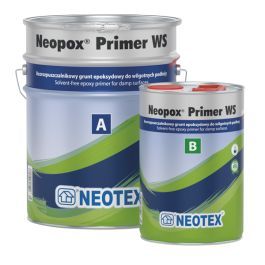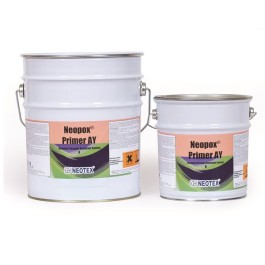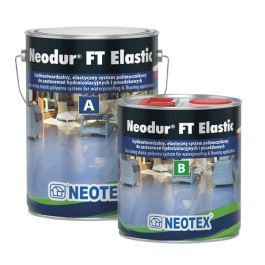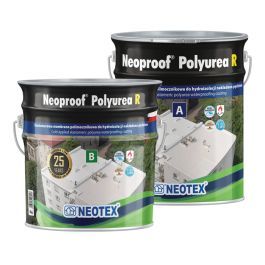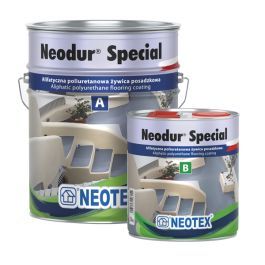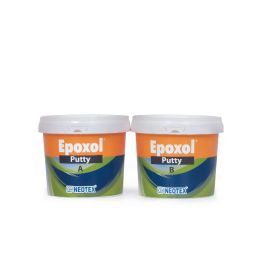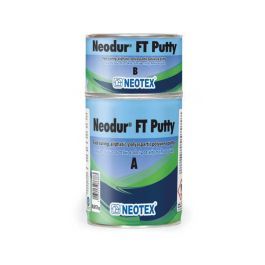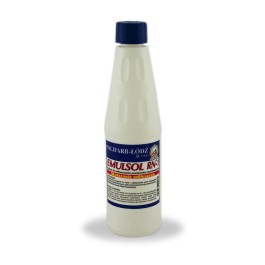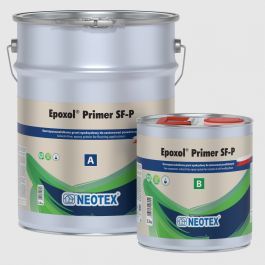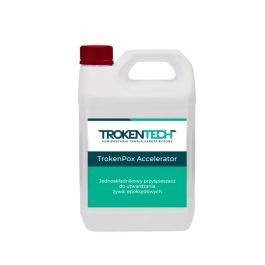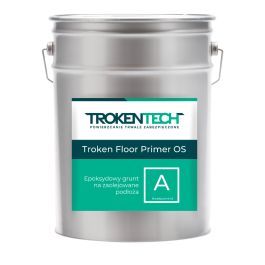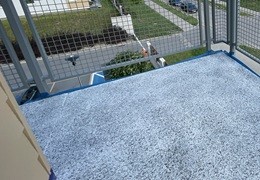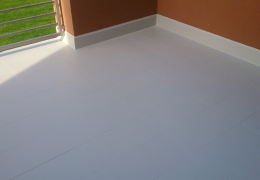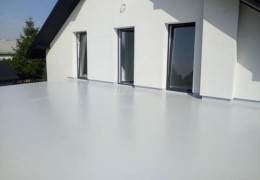Solvent-free, epoxy primer strengthening cement substrates. For internal and external use.
- Wroclaw,
- Katowice,
- Warsaw,
- Gdańsk,
- Poznań
- +48 717 026 346
Epoxy resin for the terrace
What is epoxy resin?
Epoxy resin is a synthetic material resulting from the reaction of epoxy with hardeners. After hardening, it creates an extremely durable and resistant shell. However, its natural disadvantage is the lack of resistance to UV radiation, which limits its use in open spaces such as terraces.
The main features and properties of epoxy resin
- Great adhesion - it is perfectly associated with concrete and other mineral substrates.
- Chemical resistance - does not react with many chemical substances.
- High mechanical resistance - is characterized by hardness and abrasion resistance.
- UV sensitivity - without proper protection can change color and lose its properties under the influence of the sun.
Why is epoxy resin suitable for a terrace?
Despite its sensitivity to UV radiation, epoxy resin is an excellent choice as a threating layer for more durable coatings, e.g. polyurethane . Specialized products such as Neopox® Primer WS and Neopox® Primer AY improve adhesion and strengthen the terrace surface.
Types of epoxy resins on the terrace
Neopox® Primer WS
- Used as epoxy soil for moist substrates.
- Provides excellent grip to concrete.
- Compatible with epoxy, polyurethane and polyomunic coatings.
Neopox® Primer AY
- Two -component epoxy soil with high durability.
- Protects the surface against moisture pull -up.
- It is a solid base for UV resistant coatings.
Advantages of using epoxy resin on the terrace
Resistance to atmospheric factors
properly selected epoxy soils, such as N Eopox® Primer WS and Neopox® Primer AY, effectively protect the terrace against moisture and precipitation. However, to get full resistance to UV rays, it is necessary to use a finishing layer. They can be polyurethane or polymownic resins , which are available in many color variants.
Aesthetics and ease in maintaining cleanliness
epoxy soils prepare the ground for the application of decorative coatings, improving adhesion and extending the durability of the final finish, e.g. systems based on products such as Neodur® FT Elastic , Neoproof® Polyurea R or Neodur® Special . Their flexibility allows you to apply outside, because they give up various types of contractions without fear and work with the building.
Durability and abrasion resistance
well -chosen epoxy resin in the form of soil strengthens the entire structure and prevents premature consumption of the terrace, protecting the surface against mechanical damage.
How to prepare a terrace for an epoxy resin application?
Thorough cleaning of the surface
Before starting the application, remove all dirt, fats and dust. In the case of difficult to remove stains, it is worth using degreasing agents or mechanical cleaning methods. In the case of very chopped surfaces, it may be necessary to use special degreasing preparations such as Sulfanol A or Emulsol .
Repair of cracks and unevenness
Damage in concrete substrate should be filled with appropriate repair material, such as EPOPXOL® Putty , EPOXOL® Liquid or Neodur® FT PUTTY , which will provide an even and stable surface. These are ready repair masses that can be applied after preparation. To repair the terrace floor, you can also use epoxy soil mixed with sand, e.g. EPOXOL® Primer SF-P or Neopox® Primer WS .
Application of epoxy soil
Neopox® Primer WS or Neopox® Primer Ay is applied to the prepared terrace , which strengthen the adhesion of subsequent layers and protect the surface against moisture.
How to apply epoxy resin to the terrace? Step by step
Preparation of necessary materials
For the application you will need:
- Neopox® Primer WS or Neopox® Primer AY ,
- rollers and brushes for painting,
- mechanical stirrer,
- Painting litter box.
Proper application of land
The epoxy soil should be mixed thoroughly and evenly distributed on the surface of the terrace. It is important to follow the proportion of mixing ingredients and the appropriate application time.
Curning - preliminary drying of the soil
After applying the layer of epoxy soil on the terrace, it is important to allow him to pre -hardens so that it can take another layer of the resin system . A properly primed surface is in full gloss, i.e. it shines, but it does not stick, but only shows delicate viscosity. Most often, the surface looks in this way about 24 hours after application, but it is fully dependent on the product, as well as weather conditions. Lower temperature and high humidity extend this process, while higher temperature and lower humidity can shorten it.
Applying the finishing layer
After the soil is completely dried, a UV -resistant layer is applied, e.g. Neodur® Special or systems based on Neodur® FT Elastic or Neoproof® Polyurea R.
Offer of systems and products
Solvent-free epoxy primer intended for use on concrete in the absence or incorrectly performed moisture insulation.
Polyaspartic resin providing a waterproofing effect and aesthetics on terraces and balconies. Resistant to weather conditions and UV radiation.
A two-component, cold-applied polyurea waterproofing membrane for roofs, terraces or balconies. Rain-resistant after 1 hour of application. Prevents moisture absorption and seals. Resistant to UV radiation and mechanical damage.
Neoproof Polyurea R has a European Technical Assessment (ETA 24/1247) and is classified in the highest durability category W3 according to EAD 030350-00-0402, which confirms an expected service life of up to 25 years.
Neoproof Polyurea R liquid roofing membrane is root resistant (according to CEN/TS 14416:2014 ) and certified for external fire resistance according to EN 13501-5 . Polyurea R is classified as Broof (t1) and has certified Cool Roof properties (Cool Material ).
Polyurethane resin resistant to UV radiation and other atmospheric factors. Provides high mechanical and chemical resistance.
Two-component putty for a wide range of applications. Depending on the mixing ratio of the ingredients, you can obtain a flexible, hard or very hard mass. Recommended for metal, concrete, wood and ceramics. Also for car and yacht repairs.
Mass for filling holes, gluing and repairing floors and walls. It allows sanding and repainting within 2 hours after application.
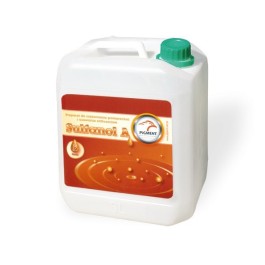
- NOTE: WATER-BASED PRODUCT. Choose temperature-controlled shipping to receive the product on the declared date, regardless of the weather. Standard shipments may be held due to temperatures below 5°C along the delivery route.
- Product
- Substrate preparation
For cleaning concrete, roof tiles and metal before applying paint coatings. Requires rinsing with water.
Concentrated agent for degreasing surfaces before painting. Mainly recommended for use before painting with anti-corrosion products.
Epoxy resin for use as a primer or construction resin. A solvent-free product for priming walls and floors and creating the so-called epoxy screeds.
Trkenpox Accelerator is a specialized land addition to accelerate the process of hardening epoxy resins. Shortens the hardening of epoxy up to 6 hours, also at low temperatures.
Two -component, non -release epoxy soil for dry and oiled concrete substrates. Strengthens the substrate, creates an adhesive layer, adheres perfectly to the concrete surfaces.
Is epoxy resin resistant to UV radiation?
keyboard_arrow_down keyboard_arrow_upNo, the standard epoxy resin is not resistant to UV. There are some deviations when the epoxy has additionally added UV filters, but this is not a standard. Therefore, only epoxy soils are used for balconies, and the top layer should be made of UV -resistant materials, such as polyurethane or polymocker coatings.
How much does epoxy resin application cost?
keyboard_arrow_down keyboard_arrow_upThe cost depends on the surface of the balcony and the materials used. The average price of epoxy soil is about PLN 50-100/m², while the final finishing layer from polyurethane costs about PLN 100-300/m².
Polyurethane or epoxy resin for the terrace?
keyboard_arrow_down keyboard_arrow_upPolyurethane resin is more flexible and resistant to UV radiation, which makes it a better choice for terraces exposed to sun. Epoxy resin can be more suitable for internal applications, while in the case of terraces it is often used as a primer.
How to care for the surface covered with epoxy resin?
keyboard_arrow_down keyboard_arrow_upIt is enough to regularly wash with water with a delicate detergent. UV resistant coatings do not require additional protection.
Proven products
Here you will find products with high strength and technical parameters. Thanks to this, you can enjoy long-lasting effects.

Help in choosing
Are you wondering which products will be best for your needs? Call us - we will advise you and choose the right solution.

Contractor support
Do you need help with construction work? Let us know and we will recommend proven contractors.
Stationary points
Do you want to collect the products in person? Or maybe you prefer to talk live? Visit our branch in: Warsaw, Wrocław, Katowice or Gdańsk.


